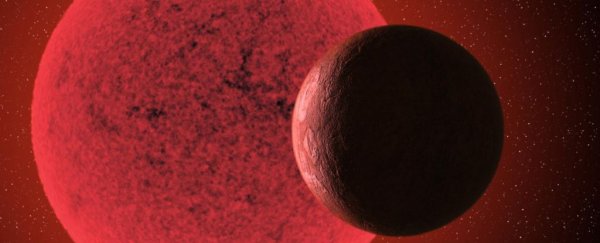The very tiny motion of a small star has revealed the presence of a super-Earth exoplanet, orbiting at a distance that is close to habitable.
Around a faint red dwarf called Ross 508, located just 36.5 light-years away (yet too dim to be seen with the naked eye), astronomers have confirmed the existence of a world just 4 times the mass of Earth. Given what we know about planetary mass limits, that means the world is likely to be terrestrial, or rocky, rather than gaseous.
The exoplanet, named Ross 508 b, is unlikely to be habitable for life as we know it; however, the discovery, a first for a new survey using the National Astronomical Observatory of Japan's (NAOJ) Subaru Telescope in Hawaii, demonstrates the efficacy of the techniques used to locate small planets around dim stars.
The hunt for habitable exoplanets is stymied somewhat by the very nature of what we believe those exoplanets to be like. The only template we have is Earth: a relatively small planet, orbiting at a distance from its star where temperatures are conducive to liquid water on the surface. This is what's known as the 'habitable zone'.
Those aren't the only factors at play, obviously – Mars falls inside the Sun's habitable zone, for instance – but they're the easiest ones to screen for.
However, the techniques we use for searching for exoplanets work best on big worlds, like gas giants, orbiting at very close distances, too hot for liquid water. That doesn't mean we can't find other kinds of worlds, but it is more difficult.
The main technique for finding exoplanets is the transit method. This is what NASA's exoplanet-hunting telescope TESS uses, and Kepler before it. An instrument stares at stars, searching for regular dips in their light, caused by an object regularly orbiting between us and the star.
The depth of this transit can be used to calculate the mass of the object; the bigger the light curve – caused by larger planets – the easier it is to spot.
At time of writing, 3,858 exoplanets found using this method have been confirmed.
The second most fruitful technique is the radial velocity method, also known as the wobble or Doppler method. When two bodies are locked in orbit, one doesn't orbit the other; rather, they orbit a mutual center of gravity. This means that the gravitational influence of any orbiting planets causes a star to wobble on the spot slightly – yep, even the Sun.
Thus, the starlight star reaching Earth is very faintly Doppler shifted. When it moves towards us, the light is slightly compressed into bluer wavelengths, and when it's moving away, it is stretched into redder wavelengths. This technique is better at detecting smaller exoplanets with wider orbits.
In 2019, an international team of astronomers led by NAOJ embarked on a survey using the Subaru Telescope to search dim red dwarf stars for exoplanets by identifying Doppler shifts in infrared and near-infrared wavelengths. This allows for a search of fainter, and therefore older and more established, red dwarf stars.
Ross 508 b, described in a paper led by astronomer Hiroki Harakawa of the Subaru Telescope, is the campaign's first exoplanet, and it's a promising one. The world is around 4 times the mass of the Sun, orbiting the star every 10.75 days.
This is much closer than Earth's orbit, you may have noticed; but Ross 508 is much smaller and fainter than the Sun. At that distance, the stellar radiation that hits Ross 508 b is just 1.4 times the solar radiation that hits Earth. This places the exoplanet very close to the outside inner edge of its star's habitable zone.
The discovery bodes very well for the future. For one, Ross 508 b transits its star. This means that TESS, which was turned to the star's sector of the sky in April and May of this year, may have obtained sufficient transit data for astronomers to discern if the exoplanet has an atmosphere. Such observations can help scientists characterize atmospheres of worlds that may be more habitable.
In addition, Ross 508, at 18 percent of the mass of the Sun, is one of the smallest, faintest stars with an orbiting world discovered using radial velocity. This suggests that future radial velocity surveys in infrared wavelengths have the potential to uncover a vast trove of exoplanets orbiting dim stars, and reveal the diversity of their planetary systems.
The team's research has been accepted into the Publications of the Astronomical Society of Japan, and is available on arXiv.
